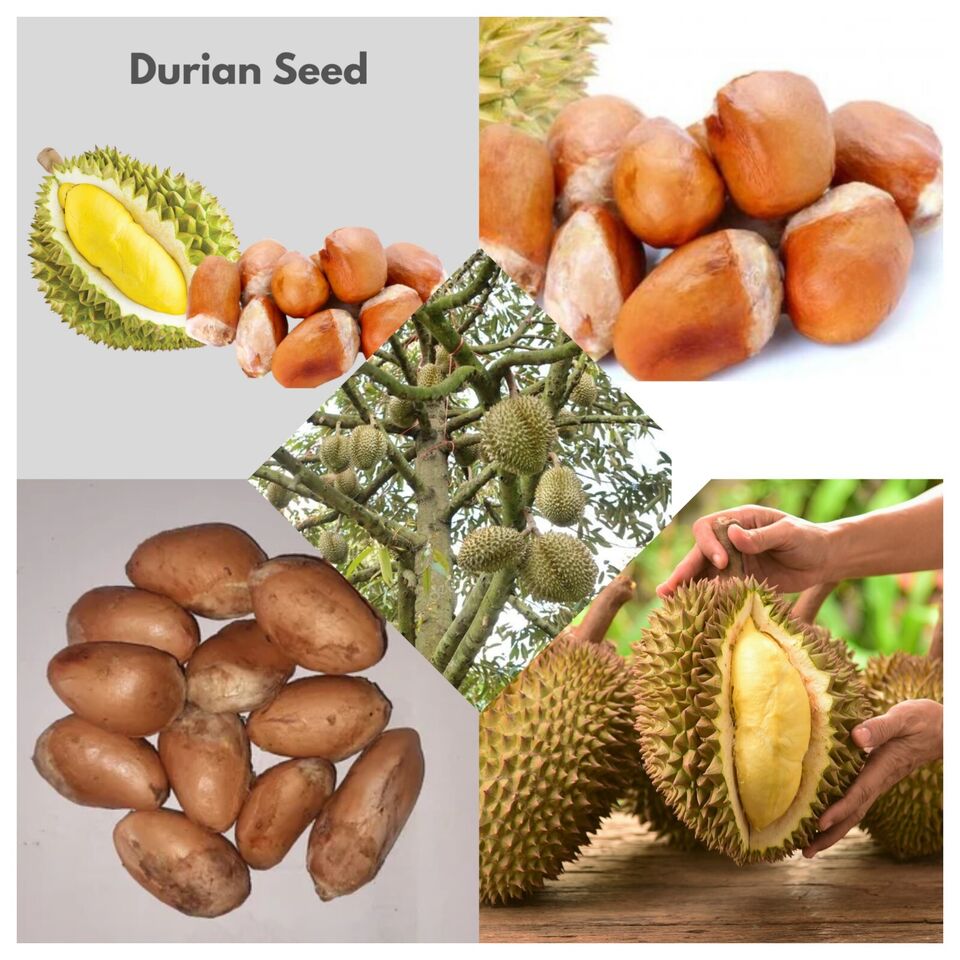Senci Green Garden
Durian Seeds (Durio zibethinus) Organic fresh x2 Seeds
Durian Seeds (Durio zibethinus) Organic fresh x2 Seeds
Couldn't load pickup availability
Durian Seeds (Durio zibethinus) x2 Seeds NON GMO Organic
100% Fresh Seeds
Durio zibethinus, commonly known as durian, is a tropical fruit tree species belonging to the Malvaceae family. It is native to Southeast Asia and is renowned for its distinctive characteristics. Here is a detailed description of Durio zibethinus:
Botanical Description
Tree:
Size: The durian tree can grow up to 25-50 meters tall, with a straight, cylindrical trunk and a broad, spreading crown.
Leaves: The leaves are evergreen, oblong, and glossy on the upper surface, with a pale, silvery underside. They can grow up to 25 centimeters long.
Bark: The bark is brown to grayish-brown and rough with shallow fissures.
Flowers
Appearance: Durian flowers are large, white to yellowish-white, and have a strong, sweet fragrance. They are borne in clusters on large branches and the trunk.
Blooming: The flowers typically bloom at night and are pollinated by bats and insects.
Fruit
Size and Shape: Durian fruits are large, typically 15-30 centimeters long and 15-20 centimeters in diameter, weighing 1-3 kilograms or more.
Husk: The fruit is covered in a thick, spiky husk that is green to brownish-green when ripe. The spines are sharp and can cause injury if not handled carefully.
Flesh: Inside the husk, the fruit is divided into several segments, each containing soft, creamy, and custard-like flesh that is yellow to golden yellow in color.
Seeds: The flesh surrounds one or more large seeds, which are brown and oval.
Odor: Durian is infamous for its strong and pungent odor, often described as a mix of rotten onions, turpentine, and raw sewage. The smell is so potent that the fruit is banned in many public places in Southeast Asia.
Habitat and Cultivation
Climate: Durian trees thrive in tropical climates with consistent temperatures between 24-30°C (75-86°F) and high humidity.
Soil: They prefer deep, well-drained, fertile soils with a pH range of 5.5 to 6.5.
Water: Regular and ample rainfall or irrigation is necessary, as durian trees require a lot of water but cannot tolerate waterlogged conditions.
Propagation: Durian is typically propagated from seeds, though grafting and budding are also common methods to ensure desirable fruit traits.
Distribution
Geographical Range: Durian is primarily grown in Southeast Asian countries, including Thailand, Malaysia, Indonesia, and the Philippines. It is also cultivated in smaller quantities in other tropical regions around the world.
Economic and Cultural Significance
Economic Value: Durian is a major commercial fruit in Southeast Asia, with a significant export market. It is often referred to as the "king of fruits" in the region.
Cultural Importance: Durian holds cultural significance and is featured in various traditional dishes, festivals, and folklore throughout Southeast Asia. It is both revered and reviled for its unique taste and smell.
Durio zibethinus is a remarkable fruit species, celebrated for its rich, creamy flesh and complex flavor, despite its controversial odor. Its cultivation and consumption are deeply embedded in the cultural and economic fabric of Southeast Asia.
Culinary Uses
Fresh Consumption: The most common way to consume durian is by eating the fresh flesh directly from the fruit. Its rich, creamy texture and complex flavor are savored by enthusiasts.
Desserts and Sweets: Ice Cream: Durian flesh is often used to make durian-flavored ice cream, which is a popular dessert in many Southeast Asian countries.
Cakes and Pastries: Durian is used as a filling or flavoring in various baked goods, including cakes, pastries, and puffs.
Candy: Durian-flavored candies and chocolates are widely available.
Sticky Rice: A popular Thai dessert combines durian with sweet sticky rice and coconut milk.
Savory Dishes
Curries: In some regional cuisines, durian is used in savory dishes, such as curries, where its unique flavor adds depth.
Beverages:
Smoothies and Shakes: Durian can be blended into smoothies and milkshakes for a rich, tropical flavor.
Durian Coffee: Durian-flavored coffee is a novelty drink enjoyed by some.
Medicinal Uses
Traditional Medicine:
Energy Booster: Due to its high calorie and carbohydrate content, durian is believed to provide an energy boost.
Digestive Health: The fiber content in durian can aid in digestion and promote a healthy gut.
Aphrodisiac: In some cultures, durian is considered an aphrodisiac.
Nutritional Benefits:
Rich in Nutrients: Durian is high in vitamins (such as vitamin C and B-complex vitamins), minerals (such as potassium and iron), and healthy fats.
Antioxidants: The fruit contains antioxidants, which can help combat oxidative stress and inflammation.
Other Uses
Cosmetic Products: Extracts from durian are sometimes used in the formulation of cosmetic products due to their antioxidant properties.
Compost: The husk and seeds of durian can be composted and used as organic fertilizer.
Overall, durian's unique taste and nutritional profile make it a versatile fruit with a variety of uses in culinary traditions, traditional medicine, and even cosmetics. Its strong smell, while divisive, does not detract from its widespread popularity and cultural significance in many parts of the world.
Share


















